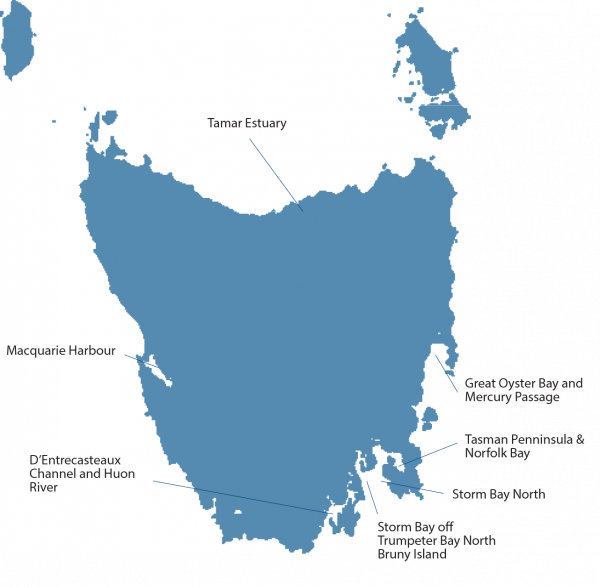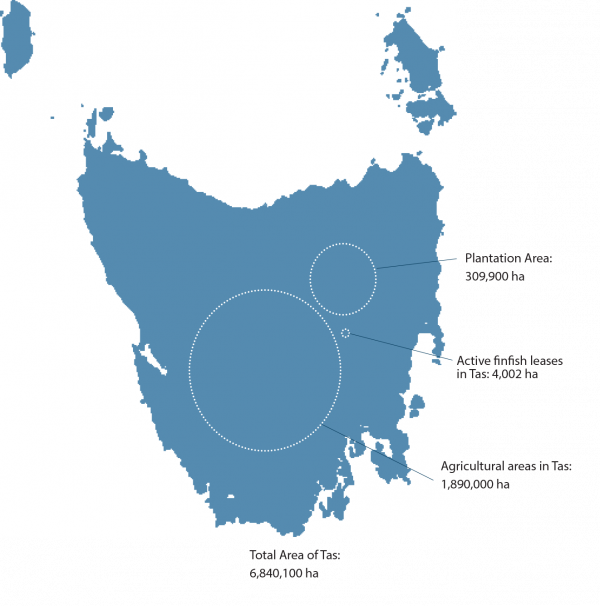Sustainability
We’ve seen and heard the word “sustainability” but what does it really mean?
For the Tasmanian salmon industry, it means having the ability to continue to farm while not impacting the environment. We think it is normal, good practice to be a sustainable company. Aquaculture relies on the health of the water and waterways; healthy waterways means healthy stock and in turn, a healthy business. The environment is at the centre of everything we do; across our freshwater hatcheries, our marine farms, our processing facilities and all our other service, support and corporate operations.
Farming salmon, like any farming production, creates an environmental footprint. For our industry, this footprint is primarily set by our government regulators with additional contributions imposed by independent global accreditors. Collectively, these authorities work together and with independent research entities to ensure this footprint undergoes constant monitoring and realignment to community expectations; an action fully supported by the Tasmanian salmon industry.
Marine Farming Leases in Tasmania

As an aside, did you know the operational footprint of all active salmon farming leases in Tasmania is just over 4,000 hectares – compared to nearly 310,000 plantation hectares and nearly 1.9 million hectares allocated for agricultural production.
Increased consumption of fish can reduce global emissions and improve human health. There is untapped potential for our oceans to produce more sustainable food and salmon is a major part of the solution. Salmon farming is one of the most efficient ways of using natural resources to produce a healthy protein: it has a low carbon footprint, high energy and protein retention efficiency and low water footprint.
Across all the different farmed animals, the Global Salmon Initiative has found that the Feed Conversion Ratio (FCR) of salmon is the lowest of all farmed animals. The FCR indicates how efficiently an animal converts feed into meat or simply, how many kilos of feed are needed to product 1kg of meat/protein. While a kg of beef meat requires between 6-10kgs of feed, a kilogram of salmon meat requires just 1.2-1.5kgs (2019 data).
Farming Leases vs Agricultural Land in Tasmania

The industry works continuously to be world-leading in terms of environmental management, fish-health practices, biosecurity, and sustainability to ensure all our stakeholders can continue to be proud of their collective efforts farming the world’s most sustainable protein. Examples include:
Wildlife Barriers
Salmon farming – like terrestrial farming is undertaken in areas where other animals live and our members work hard to keep both fish and the local wildlife safe. Seals are one of the ocean’s natural inhabitants and we have a responsibility to minimise any impact we have on them. The solution to this is good barrier technology and industry-leading pen infrastructure and nets.
Farms infrastructure is designed to minimise the threat posed to both our fish and our workers by seals. However, where the risks, particularly to workers, become unacceptably high, we believe non-lethal deterrent measures should be available to reduce that risk.
The State Government’s Seal Management Framework outlines the approved measures to manage seal interactions and sets out standards for wildlife exclusion from fish pens. This framework was a collaboration between the Tasmanian Government and industry.
By-Product Innovation
The Tasmanian salmon industry would prefer not to create any form of waste however this outcome is difficult to fully achieve when farming protein. Which is why member companies have worked very hard over the past few years to develop a whole-of-fish philosophy to drive by-product innovation. Diverting by-products from landfill is a great way to improve the sustainability of fish farming while also opening up new and potentially lucrative income streams.
A by-product is what is produced during the various farming and processing stages – essentially, the leftover materials from first-grade products, as well as non-organic materials that are no longer usable. These include (but are not limited to) salmon skins, viscera, salmon heads and frames, offcuts, graded-off smolt and fry – which is currently being used in domestic pet food while hatchery water and sludge (left over post-water filtration) is highly sought after by farmers and agriculturalists to replenish farming soil. By-products also include farming equipment such as old ropes, pipes and nets which are regularly donated by the companies to schools, wildlife shelters and other community groups.
Mitigating Climate Change Impact
Like many farmers, the industry is committed to understanding how our operations interact with a changing climate and how we can proactively mitigate climate risks for the future. Given we farm in the ocean, warming waters, ocean acidification and shifts in frequency and extreme of adverse weather events could potentially pose an ongoing challenge, the companies have taken a range of steps to mitigate this risk including:
- moving to rougher offsite farming sites where dissolved oxygen (DO) and water temperature are better for the fish;
- extending the grow-out period in onshore facilities;
- routine monitoring of sea temperature, salinity and dissolved oxygen;
- upgrading pen infrastructure to withstand extreme weather events;
- selectively breeding thermotolerant (perform better in warmer water) and disease resistant fish;
- undertaking trial with global feed companies to develop an easy-to-digest summer diet; and
- investing in renewable energy sources (Blue Economy CRC) and participation in relevant R&D projects (FRDC Storm Bay series of research projects) to ensure our farming practices continue to adapt.
Health Benefits of Eating Salmon
The health benefits of salmon are well documented. It is dubbed as one of only 14 known ‘superfoods’ and the inclusion of salmon in human diet is now even more critical if the current population is to avoid becoming the first generation to have a lower life expectancy than its predecessor.
While progress has been made globally to reduce infectious diseases, cardiovascular, nervous and autoimmune system diseases are on the increase. And other diet-related problems such as obesity, depression and mental illnesses now rank as an even bigger health issue for European populations.
Salmon is recognised as a superfood because of its nutrient profile and health-protecting qualities, making it a great way to fuel your body. The superfood status is a result of salmon containing large amounts of omega-3 fatty acids (commonly called omega-3 DHA) and being low in saturated fat and calories yet high in protein.
In addition to cardiovascular benefits, a diet rich in omega-3 has also been found to assist with easing joint or arthritis pain by decreasing inflammation as well as brain development and function. The human brain is 60 per cent structural fat and in order to function properly needs the right kind of fat (omega-3s) to make sure that signals are passed quickly and easily between the membranes of the brain cells. Omega-3 cannot be produced naturally by the body and must be obtained from food consumption.
Salmon is also rich in high-quality protein (another essential nutrient to help the body heal after injury, protect bone health and maintain muscle mass), an excellent source of several vitamins (D, B6, B12 needed for energy production, controlling inflammation and protecting heart health) and a good source of Potassium.
The Australian Heart Foundation recommends people consume 250-500mg of omega-3 daily. A 100g portion of fresh Huon Salmon contains 1,400mg of omega-3 – as per the Nutritional Information Panels. By way of comparison, 6 oysters contain 370mg of omega-3, while one serving of grass fed sirloin steak contains 60mg (www.heartfoundation.org.au)